

This study explored the personal interaction and process of compiling and reviewing high school history textbooks under the textbook policy of “one guide for multiple texts.” The primary research methods were interviews and document analysis. Twelve individuals were interviewed for this study, including four textbook writers, each representing a different textbook, four editors, each from a different publishing company, and four members of the textbook review committee. Document analysis was based on the National Institute for Compilation and Translation’s history textbook review documents. The analysis discovered that under the current censorship system, the power relations among writers and reviewers,disagreements over the new curriculum guidelines, disputes regarding historical knowledge and teaching methods, and interpretations of the core competencies affected the interaction between the writers and reviewers. The seeminglyantagonistic editorial process of the current censorship system also showed that the views of the writers and reviewers differed significantly. However, the “greatest common denominator” principle was developed between both parties to resolve disputes under time constraints and for the need to “complete the mission.” However, this principle indirectly avoided the issue of how to cultivate and teach the four core competencies emphasized by the new curriculum guidelines. Furthermore, a “textcentric” instead of “learner-centric” logic is still employed during the textbook compilation process. Making a new kind of history textbooks which can be a bridge leading teachers and students to a new paradigm in learning history is a crucial step for accomplishing the goals of the new curriculum. However, this topic has been ignored in the current editorial process.

This work is licensed under a Creative Commons Attribution-NonCommercial 3.0 Taiwan License.
Center for Educational Research and Innovation, National Tawain Normal University
162, Ho-Ping East Rd, Sec. 1, Taipei, Taiwan | Tel:+886-2-7749-3670 | E-mail: cerecerq@gmail.com
CERI | NTNU | E-mail Alerts | Open Journal System
© 2014 CERI-NTNU
